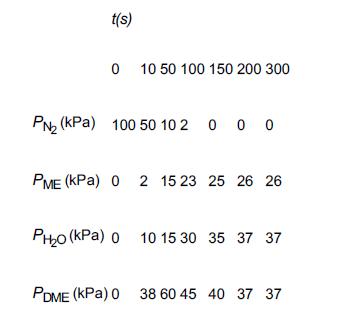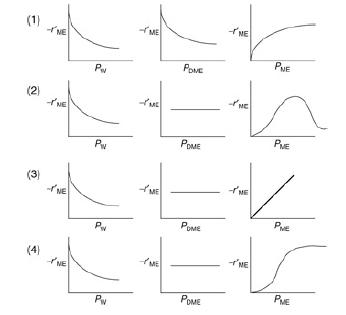The catalytic dehydration of methanol (ME) to form dimethyl ether (DME) and water was carried out over
Question:
The catalytic dehydration of methanol (ME) to form dimethyl ether (DME) and water was carried out over an ion exchange catalyst (K. Klusacek, Collection Czech. Chem. Commun., 49, 170 (1984)). The packed bed was initially filled with nitrogen, and at t = 0. The N2 feed is switched to pure methanol vapor entering the reactor at 413 K, 100 kPa, and 0.2 cm3/s. The following partial pressures were recorded at the exit to the differential reactor containing 1.0 g of catalyst in 4.5 cm3 of reactor volume.
2CH3→CH3OCH3+H2O
TABLE P10-8B PARTIAL PRESSURE OF H2, ME, AND DME EXITING THE REACTOR AFTER TIME
Use parts (a) through (f) to lead you to suggest a mechanism, rate-limiting step, and rate law consistent with this data.
a. Using the data above, sketch the exit concentrations as a function of time.
b. Which species took longer than others to exit the reactor in the gas phase? What could have caused this difference in exit times?
c. What species are adsorbed on the surface?
d. Are any species not adsorbed on the surface? If so, which ones?
e. Which set of figures in Figure P10-8B correctly describes the functionality of the chemical reaction rate with the partial pressure PW, PDME, and PME? f. Derive a rate law for the catalytic dehydration of methanol. Dimethyl Ether 2ME → DME + W.
f. Derive a rate law for the catalytic dehydration of methanol. Dimethyl Ether 2ME → DME + W.
Four sets of graphs portraying different functionalities of chemical reaction rate in the form of different curves. It compares the partial pressures of P subscript W, P subscript DME, and P subscript ME with negative r prime subscript ME all four sets. In the first set, the first graph represents a downward curve from negative r prime subscript ME decreasing with increasing values of P subscript W. The second graph is similar to the first graph representing a decreasing curve. The third graph represents a curve arching from the origin, across negative r prime subscript ME and P subscript ME respectively. The first graphs in all 4 sets are identical. In the second set, the second graph represents a horizontal line, denoting the constant negative r prime subscript ME for increasing values of P subscript DME. The third graph represents a curve open inward, that is, it starts at the origin raises up and falls, across negative r prime subscript ME and P subscript ME respectively. The second graphs in sets 2, 3, and 4 are identical. In the third set, graph 3 represents a linear curve, that is, a straight line from the origin across the negative r prime subscript ME and P subscript ME respectively. In the fourth set, graph 3 is a bent curve, it begins at the origin gradually increases and bends flat, as a curve with constant negative r prime subscript ME value for increasing P subscript ME respectively.
Step by Step Answer:






